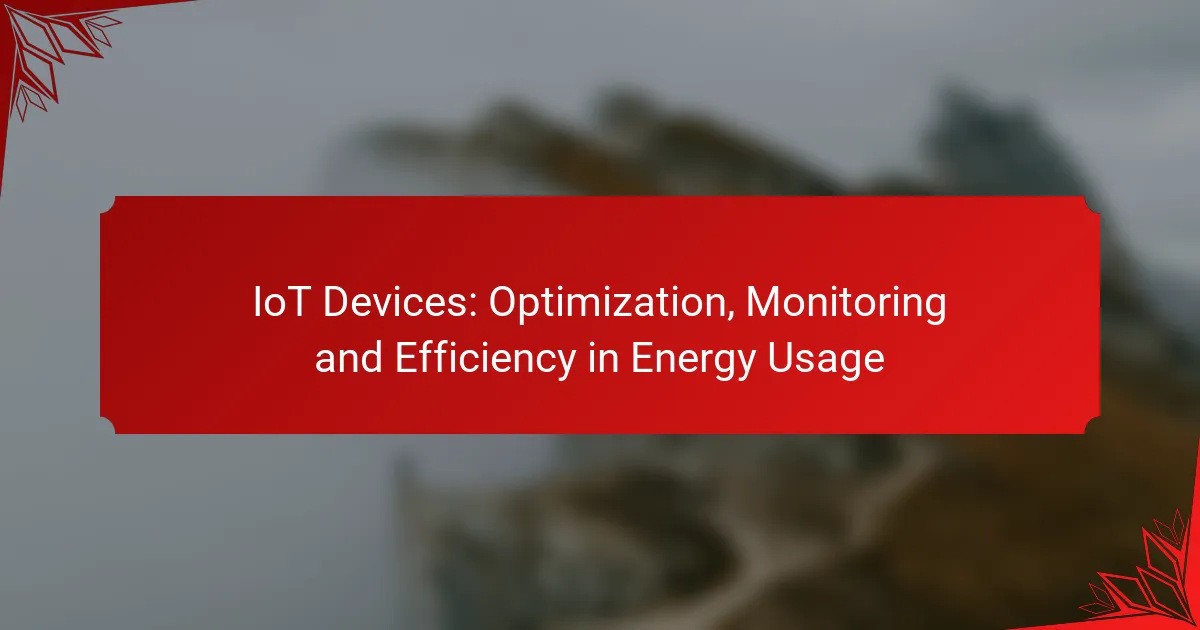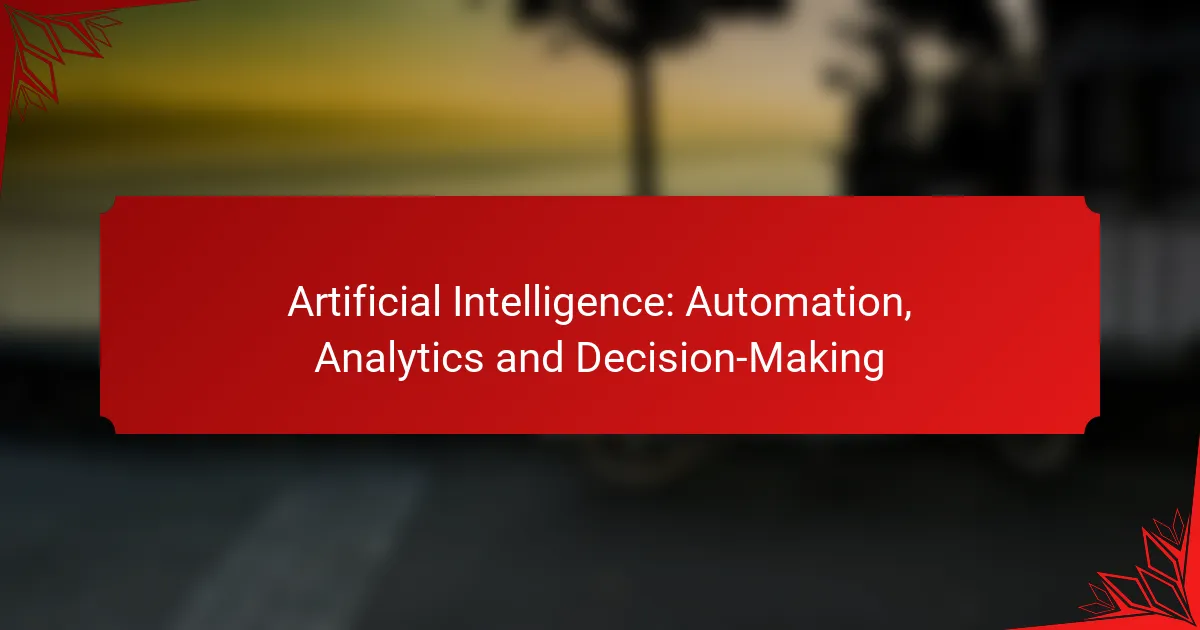The integration of IoT devices into energy management systems offers a transformative approach to optimizing energy usage in both homes and businesses. By enabling real-time monitoring and control, these devices empower users to automate consumption patterns, leading to significant cost savings and enhanced sustainability. Through data-driven insights, organizations can effectively reduce their energy footprint while improving operational efficiency.
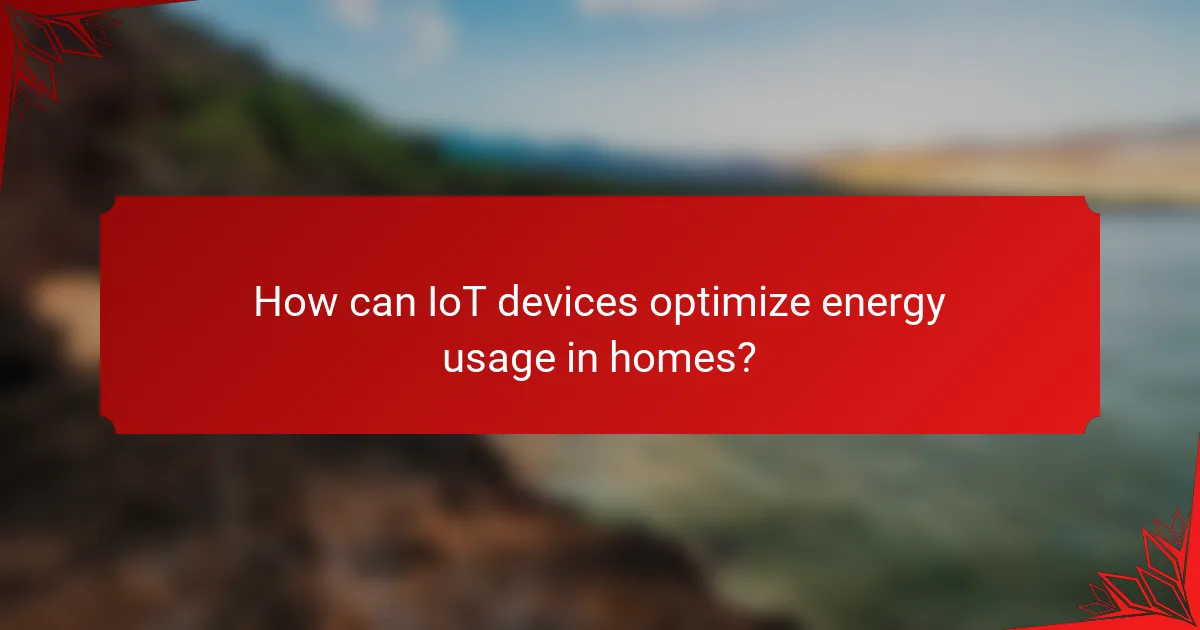
How can IoT devices optimize energy usage in homes?
IoT devices can significantly enhance energy efficiency in homes by automating and optimizing energy consumption patterns. By utilizing smart technology, homeowners can monitor usage, adjust settings remotely, and receive insights that lead to reduced energy bills and a smaller carbon footprint.
Smart thermostats
Smart thermostats learn your heating and cooling preferences and adjust settings automatically to optimize energy usage. By using sensors and algorithms, they can reduce energy consumption when you’re away and ensure comfort when you’re home. Many models allow remote control via smartphone apps, enabling you to make adjustments on the go.
Consider models that integrate with other smart home devices for maximum efficiency. Some smart thermostats can even provide energy usage reports, helping you identify trends and areas for improvement.
Energy monitoring systems
Energy monitoring systems track real-time energy consumption across various devices in your home. These systems provide detailed insights into which appliances use the most energy, allowing you to make informed decisions about usage. Many systems offer alerts for unusual spikes in consumption, helping you identify potential issues early.
Look for systems that provide historical data and trends, as this can help you adjust your habits over time. Some energy monitors can integrate with smart home platforms, enhancing their functionality.
Automated lighting controls
Automated lighting controls adjust the brightness or turn off lights based on occupancy or time of day, significantly reducing energy waste. Motion sensors and timers can ensure that lights are only on when needed, which is particularly useful in rooms that are not frequently used.
Consider using smart bulbs that can be programmed or controlled remotely. Many of these bulbs also allow for dimming, which can further reduce energy usage while providing the desired ambiance.
Smart appliances
Smart appliances, such as refrigerators, washing machines, and dishwashers, can optimize energy usage by running during off-peak hours or adjusting their operation based on energy prices. These appliances often come with energy-saving modes that can be activated through a smartphone app.
When selecting smart appliances, look for those with high energy efficiency ratings, such as ENERGY STAR certifications, to ensure you are making a sustainable choice.
Home energy management systems
Home energy management systems (HEMS) provide a comprehensive view of your home’s energy consumption, allowing for better control and optimization. These systems can integrate various IoT devices to create a cohesive strategy for energy savings, including scheduling and automation features.
Implementing a HEMS can lead to significant savings, especially when combined with renewable energy sources like solar panels. Evaluate systems that offer user-friendly interfaces and detailed analytics to maximize your energy efficiency efforts.
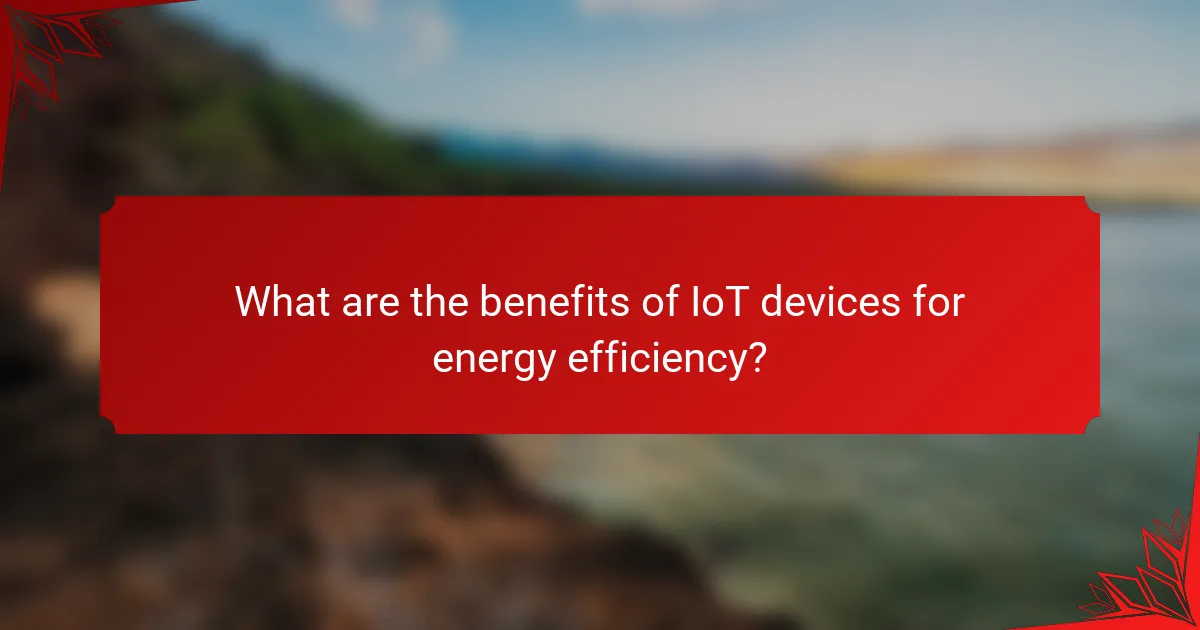
What are the benefits of IoT devices for energy efficiency?
IoT devices significantly enhance energy efficiency by enabling smarter energy consumption and management. They allow users to monitor and control energy usage in real-time, leading to reduced costs and improved sustainability.
Reduced energy costs
By using IoT devices, households and businesses can lower their energy expenses through optimized usage patterns. Smart thermostats, for instance, adjust heating and cooling based on occupancy, potentially saving 10-20% on energy bills.
Additionally, automated lighting systems can turn off lights in unoccupied areas, further decreasing unnecessary energy expenditure. Implementing these technologies can lead to substantial savings over time.
Improved energy management
IoT devices provide enhanced energy management by allowing users to track consumption patterns and identify inefficiencies. Smart meters can provide detailed insights into energy usage, helping users make informed decisions about their consumption habits.
With the ability to set schedules and automate devices, users can ensure that energy is used only when necessary, contributing to overall efficiency. This proactive approach to energy management can align with local regulations aimed at reducing carbon footprints.
Enhanced user convenience
IoT devices offer significant convenience by enabling remote control and automation of energy-consuming appliances. Users can manage their systems through mobile apps, allowing for adjustments from anywhere, which is particularly useful for busy lifestyles.
For example, a user can preheat an oven or adjust the thermostat while away from home, ensuring comfort upon arrival without wasting energy. This level of control enhances the user experience while promoting energy efficiency.
Real-time data insights
Real-time data insights from IoT devices empower users to make quick decisions regarding their energy usage. By accessing live data on consumption, users can identify peak usage times and adjust their habits accordingly to avoid higher rates.
Moreover, these insights can help in predicting future energy needs, allowing for better planning and resource allocation. Utilizing data analytics can lead to smarter energy consumption strategies, ultimately supporting sustainability goals.
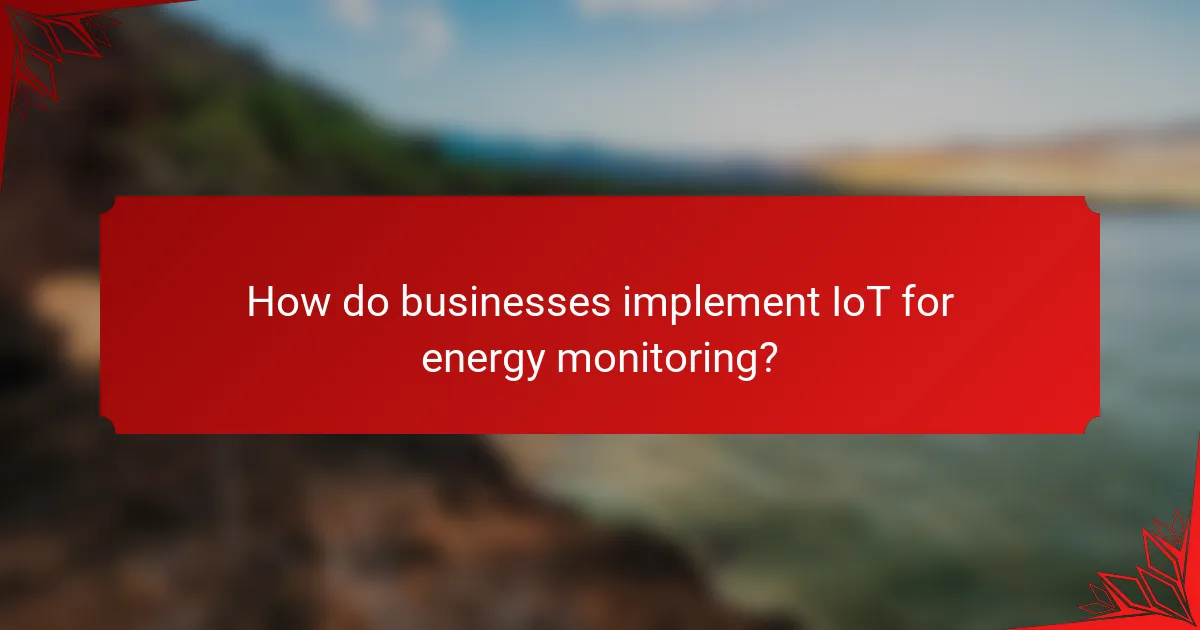
How do businesses implement IoT for energy monitoring?
Businesses implement IoT for energy monitoring by deploying connected devices that track energy usage in real-time. This technology enables organizations to optimize consumption, reduce costs, and enhance operational efficiency through data-driven insights.
Installation of IoT sensors
The first step in implementing IoT for energy monitoring is the installation of sensors throughout the facility. These sensors can measure various parameters such as temperature, humidity, and energy consumption at different points in the system. Placement is crucial; sensors should be installed in areas with high energy usage to provide the most accurate data.
Common types of sensors include smart meters, which track electricity usage, and environmental sensors, which monitor conditions that affect energy efficiency. Businesses should consider the compatibility of sensors with existing infrastructure to ensure seamless integration.
Integration with existing systems
After installing IoT sensors, the next step is integrating them with existing energy management systems. This may involve connecting sensors to a centralized platform that can collect and analyze data. Businesses should assess their current systems to determine the best integration approach, whether through APIs or direct connections.
Successful integration allows for real-time monitoring and control, enabling businesses to respond quickly to energy usage patterns. It is essential to ensure that the integration process maintains data security and complies with relevant regulations.
Data analysis platforms
Data analysis platforms play a vital role in interpreting the data collected from IoT sensors. These platforms can provide insights into energy consumption trends, identify inefficiencies, and suggest optimization strategies. Businesses can choose from various software solutions, ranging from simple dashboards to advanced analytics tools.
When selecting a data analysis platform, consider factors such as scalability, ease of use, and the ability to generate actionable reports. Regularly reviewing the data can help businesses make informed decisions about energy usage and identify areas for improvement, ultimately leading to cost savings and enhanced sustainability.
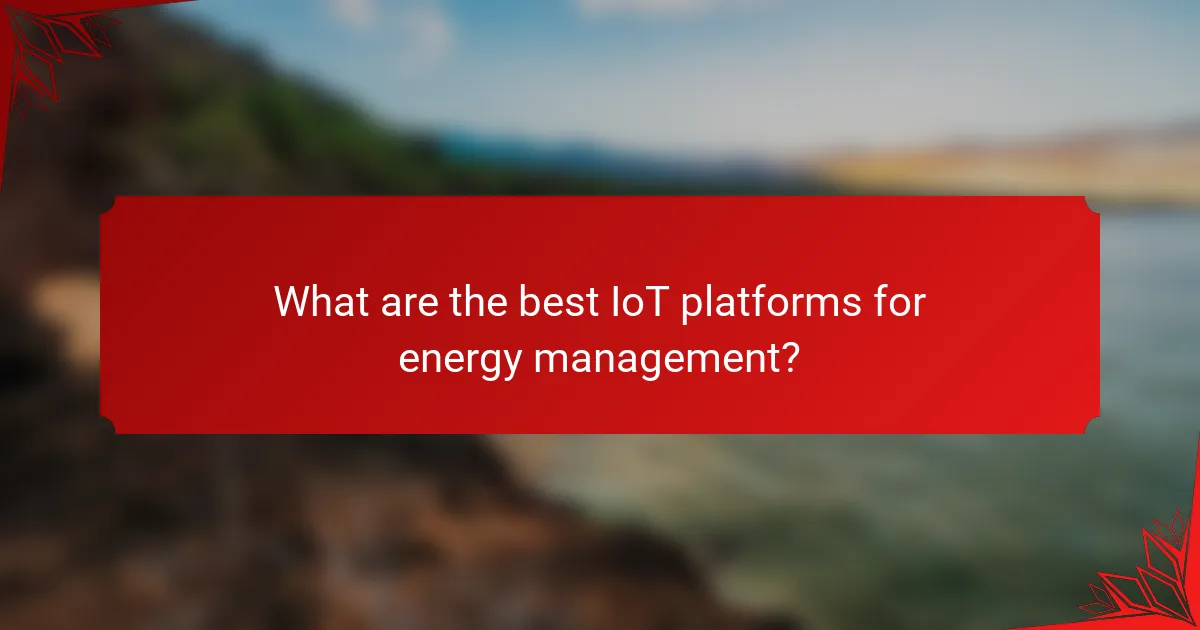
What are the best IoT platforms for energy management?
The best IoT platforms for energy management include solutions that enable users to monitor, control, and optimize energy consumption effectively. These platforms often integrate with smart devices, providing real-time data and automation features to enhance energy efficiency.
Google Nest
Google Nest offers a range of smart home devices that focus on energy efficiency, particularly through its smart thermostats. These thermostats learn user habits and adjust heating and cooling automatically, potentially reducing energy bills by up to 15%.
To maximize benefits, ensure your Nest devices are connected to Wi-Fi for real-time updates and control. Regularly review energy reports provided by the app to identify patterns and areas for improvement.
Amazon Alexa
Amazon Alexa serves as a central hub for various smart home devices, allowing users to manage energy consumption through voice commands and routines. By integrating smart plugs and lights, users can schedule when devices turn on or off, leading to more efficient energy use.
Consider using Alexa’s energy dashboard to track usage and set reminders for energy-saving actions. Be cautious of overloading smart plugs, as this can lead to safety hazards.
Samsung SmartThings
Samsung SmartThings provides a comprehensive platform for managing smart devices, including energy-efficient appliances. It allows users to create automation scenarios that optimize energy use based on real-time data.
Utilize SmartThings to monitor energy consumption patterns and set up alerts for unusual usage. This proactive approach can help identify devices that consume excessive energy and need attention.
EcoStruxure by Schneider Electric
EcoStruxure is designed for commercial and industrial applications, focusing on energy management and sustainability. It offers advanced analytics and IoT connectivity to optimize energy performance across facilities.
For businesses, implementing EcoStruxure can lead to significant cost savings and improved operational efficiency. Regularly assess the analytics provided to make informed decisions about energy usage and sustainability initiatives.
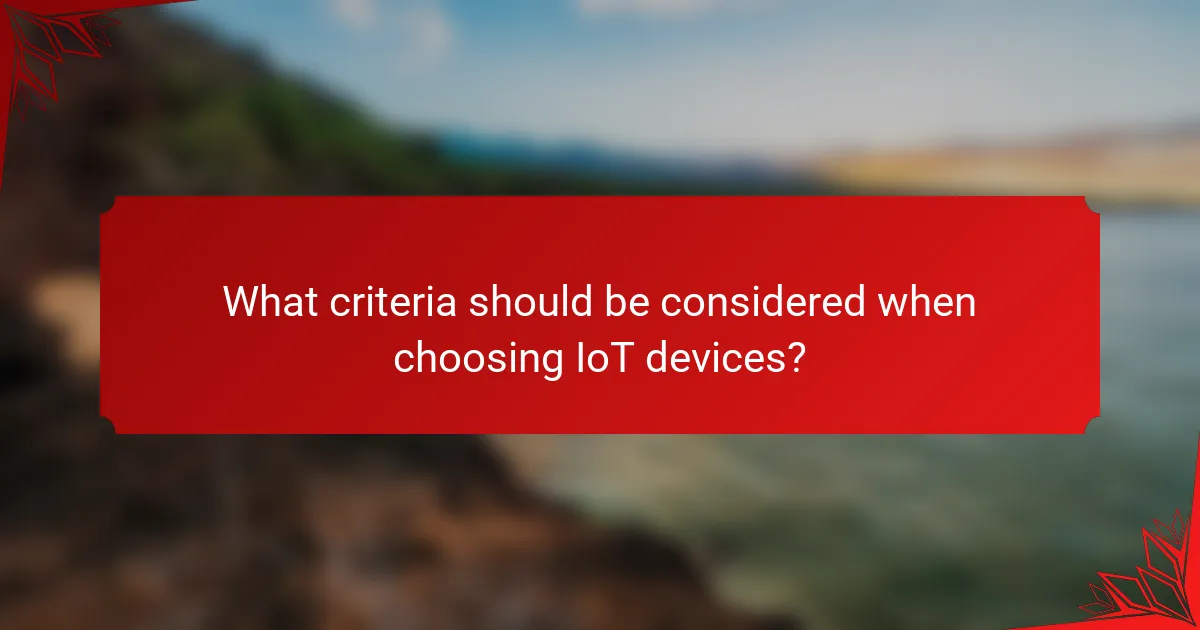
What criteria should be considered when choosing IoT devices?
When selecting IoT devices, it’s essential to evaluate compatibility with existing systems, scalability for future growth, and robust data security features. These criteria ensure that the devices will integrate smoothly, adapt to evolving needs, and protect sensitive information.
Compatibility with existing infrastructure
Compatibility is crucial as it determines how well new IoT devices will work with your current systems. Check if the devices support the same communication protocols (like Wi-Fi, Zigbee, or Bluetooth) and can integrate with existing software platforms. For example, a smart thermostat should easily connect to your home automation system without requiring extensive modifications.
Before making a purchase, review the manufacturer’s documentation and consider conducting a pilot test with a small number of devices. This approach helps identify potential integration issues early on, saving time and resources in the long run.
Scalability for future needs
Scalability refers to the ability of IoT devices to grow with your needs. Choose devices that can accommodate additional units or features without significant upgrades or replacements. For instance, if you start with a few smart sensors, ensure the system can handle dozens more as your project expands.
Look for platforms that offer modular solutions or cloud-based services, which can easily add capacity. This flexibility can be particularly beneficial in sectors like agriculture or manufacturing, where demands may change rapidly.
Data security features
Data security is a top priority when selecting IoT devices, as vulnerabilities can expose sensitive information. Ensure that the devices support encryption protocols, secure authentication methods, and regular firmware updates. For example, devices that comply with standards like GDPR or CCPA may offer better protection for personal data.
It’s advisable to review the security practices of the manufacturer and check for any history of breaches. Implementing additional security measures, such as network segmentation and regular audits, can further safeguard your IoT ecosystem.
